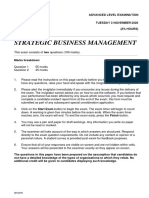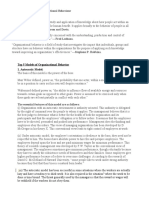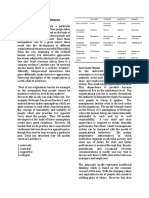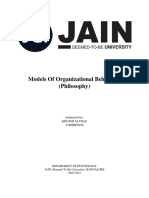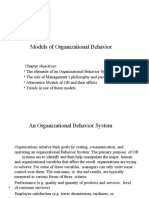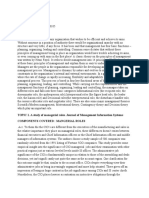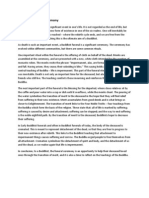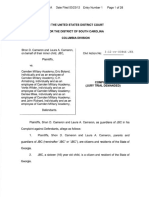STUDYGUIDE5
STUDYGUIDE5
Uploaded by
Lyneah MonteverdeOriginal Description:
Copyright
Available Formats
Share this document
Did you find this document useful?
Is this content inappropriate?
Report this DocumentCopyright:
Available Formats
STUDYGUIDE5
STUDYGUIDE5
Uploaded by
Lyneah MonteverdeCopyright:
Available Formats
FM-AA-CIA-15 Rev.
0 10-July-2020
Study Guide in PA 104: HUMAN BEHAVIOR IN ORGANIZATION Module No. 5
STUDY GUIDE FOR MODULE NO. ___
5
CHAPTER 5: MODELS OF ORGANIZATIONAL BEHAVIOR
MODULE OVERVIEW
This module aims to discuss in greater detail the various behavior of individual organization
members and groups within organizations. The emphasis will be on the alteration of organizational
behavior theories to practices that may result in organizational effectiveness and efficiency. The
primary goal of this module is to provide the students with an extensive knowledge for advanced
leadership roles and to prepare them in facing the challenges involved in modern organization as well.
This section of the module focuses on the Models of Organizational Behavior. These models
are the techniques which will help us to understand complex things and ideas concerning
organizations in a clear manner. All the models of organizational behavior are broadly classified into
five types: autocratic, custodial, supportive, collegial, and system model.
MODULE LEARNING OBJECTIVES
At the end of this module, the student will be able to:
1) Be familiar with the theories and models of organizational behavior
2) Compare and contrast the different theories and models
LEARNING CONTENTS (title of the subsection)
Models of Organizational Behavior
Organization differ in quality of the systems and the procedures they develop and maintain and in the
results they accomplish. Different theories of organizational behavior bring out varying results. These
theories constitute the belief system and management orientation that consequently affect the
organization. It is in the premise that managers recognize the nature, significance, and effectiveness
of a particular theory suited to the problem.
A. Autocratic Model
Autocratic model is the model that depends upon strength, power and formal authority. In an
autocratic organization, the people (management/owners) who manage the tasks in an
organization have formal authority for controlling the employees who work under them. These
lower-level employees have little control over the work function. Their ideas and innovations are
not generally welcomed, as the key decisions are made at the top management level.
To be familiar with the Essential features of this model, click
https://www.yourarticlelibrary.com/organization/organizational-behaviour/top-5-models-of-
organizational-behavior-explained/63749
B. Custodial Model
The custodial model is based around the concept of providing economic security for employees –
through wages and other benefits – that will create employee loyalty and motivation. The
underlying theory for the organization is that they will have a greater skilled workforce, more
motivated employees, and have a competitive advantage through employee knowledge and
expertise.
One of the downsides with the custodial model is that it also attracts and retains low performance
staff as well. Or perhaps even deliver a lower level of motivation from some staff who feel that
they are “trapped” in an organization because the benefits are too good to leave.
PANGASINAN STATE UNIVERSITY 1
FM-AA-CIA-15 Rev. 0 10-July-2020
Study Guide in PA 104: HUMAN BEHAVIOR IN ORGANIZATION Module No. 5
Some of the important features of this model are explained in this link:
https://www.yourarticlelibrary.com/organization/organizational-behaviour/top-5-models-of-
organizational-behavior-explained/63749
C. Supportive Model
Unlike the two earlier approaches, the supportive model focused around aspiring leadership. It is
not based upon control and authority (the autocratic model) or upon incentives (the custodial
model), but instead tries to motivate staff through the manager-employee relationship and how
employees are treated on a day-to-day basis. Quite opposite to the autocratic model, this
approach states that employees are self-motivated and have value and insight to contribute to the
organization, beyond just their day-to-day role. The intent of this model is to motivate employees
through a positive workplace where their ideas are encouraged and often adapted. Therefore, the
employees have some form of “buy-in” to the organization and its direction.
The main features of this model can be read using the link below:
https://www.yourarticlelibrary.com/organization/organizational-behaviour/top-5-models-of-
organizational-behavior-explained/63749
LEARNING CONTENTS (title of the subsection)
D. Collegial Model
The collegial model is based around teamwork – everybody working as colleagues (hence the
name of the model). The overall environment and corporate culture need to be aligned to this
model, where everybody is actively participating – is not about status and job titles – everybody is
encouraged to work together to build a better organization.
The role of the manager is to foster this teamwork and create positive and energetic workplaces.
In much regard, the manager can be considered to be the “coach” of the team. And as coach, the
goal is to make the team perform well overall, rather than focus on their own performance, or the
performance of key individuals. The collegial model is quite effective in organizations that need to
find new approaches – marketing teams, research and development, technology/software –
indeed anywhere the competitive landscape is constantly changing and ideas and innovation are
key competitive success factors.
To know the features of this model, click this link:
https://www.yourarticlelibrary.com/organization/organizational-behaviour/top-5-models-of-
organizational-behavior-explained/63749
E. System Model
This is the most contemporary model of the five models discussed in this article. In the system
model, the organization looks at the overall structure and team environment, and considers that
individuals have different goals, talents and potential. The intent of the system model is to try and
balance the goals of the individual with the goals of the organization.
Individuals obviously want good remuneration, job security, but also want to work in a positive
work environment where the organization adds value to the community and/or its customers. The
system of model should be an overall partnership of managers and employees with a common
goal, and where everybody feels that they have a stake in the organization.
LEARNING ACTIVITY 1
Case Study No. 8
(to be posted on LMS/Class Messenger GC)
Quiz (thru LMS)
SUMMARY
In designing an effective organizational structure, there are a number of principles and concepts
that are interrelated and that have a predictive value for managers. Some theories give guidelines
PANGASINAN STATE UNIVERSITY 2
FM-AA-CIA-15 Rev. 0 10-July-2020
Study Guide in PA 104: HUMAN BEHAVIOR IN ORGANIZATION Module No. 5
explaining relationships between two or more variable.
Different theories of organizational behavior bring out varying results. These theories constitute
the belief system and management orientation that consequently affect the organization. This chapter
throws light on the five important models of organizational behavior, the Autocratic Model, Custodial
Model, the Supportive Model, Collegial Model, and the System Model
The Autocratic Model approach depends on power and authority. In autocratic work
environment, the managerial orientation is very formal. The authority is delegated by right of
command over the people to whom it applies.
Custodial Model is described in its extreme order to show its emphasis on material rewards,
security needs, and organizational dependence of employees.
The supportive model depends on leadership instead of power or money. Through leadership,
management provides a climate to help employees grow and accomplish in the interest of the
organization the things of which they are capable.
Collegial model traditionally was used less on assembly lines because the rigid work
environment made it difficult to develop there. It embodies a team concept, first achieved widespread
applications in research laboratories and similar work environments.
System model is the result of a strong search for higher meaning at work by many of today’s
employees.
REFERENCES
Electronics:
https://www.myorganisationalbehaviour.com/five-models-of-organisational-behaviour/
https://www.yourarticlelibrary.com/organization/organizational-behaviour/top-5-models-of-
organizational-behavior-explained/63749
https://ebrary.net/2814/management/models_organiational_behaviour
Book/s:
Greenberg, Gerald G. 1999. Managing Behavior in Organizations. Second Edition. French-Hall Inc.
USA
Johns, Gary. 1997. Organizational Behavior. 4th edition
Medina, Roberto G. (2011). Human Behavior in Organization
PANGASINAN STATE UNIVERSITY 3
You might also like
- Organizational Behavior Human Behavior at Work 14th Edition Newstrom Solutions ManualDocument15 pagesOrganizational Behavior Human Behavior at Work 14th Edition Newstrom Solutions Manuala71349573883% (6)
- Private ATM Business PlanDocument9 pagesPrivate ATM Business PlanArindomNo ratings yet
- Dwnload Full Organizational Behavior Human Behavior at Work 14th Edition Newstrom Solutions Manual PDFDocument36 pagesDwnload Full Organizational Behavior Human Behavior at Work 14th Edition Newstrom Solutions Manual PDFdanielmoreno72d100% (15)
- Strategic Business Management Exam November 2020Document19 pagesStrategic Business Management Exam November 2020Wong Andrew0% (1)
- Autocratic ModelDocument5 pagesAutocratic ModelVenkatesh KesavanNo ratings yet
- Tiffany v. LVMH ComplaintDocument114 pagesTiffany v. LVMH ComplaintThe Fashion LawNo ratings yet
- Credit Transactions MCQDocument4 pagesCredit Transactions MCQdaylojerome100% (2)
- Module 2 HBODocument4 pagesModule 2 HBOMarjan ValmonteNo ratings yet
- Organizational Behavior Model NotesDocument12 pagesOrganizational Behavior Model NotesSanjeevani PandeyNo ratings yet
- Different Models of Organisational BehaviourDocument20 pagesDifferent Models of Organisational BehaviourAyaan KhanNo ratings yet
- Models of Organisational Behaviour PDFDocument8 pagesModels of Organisational Behaviour PDFOTP On the pointNo ratings yet
- Models of Organizational Behaviour: S-O-B-C Model of Human BehaviourDocument8 pagesModels of Organizational Behaviour: S-O-B-C Model of Human BehaviourPAULOMI DASNo ratings yet
- Organizational Culture LeadershipDocument5 pagesOrganizational Culture LeadershipBorinaga, Jenilyn I.No ratings yet
- Assignment No.2 Course: Management Strategies in Educational Institutions (8615) Semester: Spring, 2022 Level: B.Ed. (1.5 YearsDocument20 pagesAssignment No.2 Course: Management Strategies in Educational Institutions (8615) Semester: Spring, 2022 Level: B.Ed. (1.5 Yearsmunn chNo ratings yet
- Organisational Behaviour 1Document4 pagesOrganisational Behaviour 1Arnold JustinNo ratings yet
- Introduction of Organizational BehaviorDocument11 pagesIntroduction of Organizational BehaviorjsprambleNo ratings yet
- Models of Organizational BehaviourlogoDocument27 pagesModels of Organizational Behaviourlogoitee0510No ratings yet
- Organizational Behavior - Our Inherent Power of Generalization Helps Us To Predict TheDocument19 pagesOrganizational Behavior - Our Inherent Power of Generalization Helps Us To Predict TheJay Mark EscondeNo ratings yet
- Choose Healthy Foods For You and Your FamilyDocument4 pagesChoose Healthy Foods For You and Your FamilyNormawati RazakNo ratings yet
- Ob Notes Unit I BBADocument34 pagesOb Notes Unit I BBAVikas SharmaNo ratings yet
- OB Assignment-1Document6 pagesOB Assignment-1MUHAMMED FARSIN ENo ratings yet
- Models of Organizational BehaviorDocument11 pagesModels of Organizational Behaviorulanrain311No ratings yet
- Models of Organizational BehaviourDocument5 pagesModels of Organizational BehaviourKHUSHI ALTHAFNo ratings yet
- Pages 38 - 44Document9 pagesPages 38 - 44itsme_ayienNo ratings yet
- Models of OBDocument5 pagesModels of OBabhiisharma0504No ratings yet
- The Four Models of Organizing BehaviorDocument10 pagesThe Four Models of Organizing BehaviorDanish RazaNo ratings yet
- Models of Organizational Behavior-BriefDocument15 pagesModels of Organizational Behavior-BriefVikram ShahNo ratings yet
- Models of Organizational BehaviorDocument13 pagesModels of Organizational BehavioruddindjmNo ratings yet
- Models of Organizational BehaviorDocument3 pagesModels of Organizational BehaviorJaya AravindNo ratings yet
- Chapter-2 Models of Organizational Behavior (Group-2)Document28 pagesChapter-2 Models of Organizational Behavior (Group-2)SabbirNo ratings yet
- OB ReportDocument7 pagesOB ReportRajarshi RoychoudhuryNo ratings yet
- Organizational Behavior Human Behavior at Work 14th Edition Newstrom Solutions ManualDocument26 pagesOrganizational Behavior Human Behavior at Work 14th Edition Newstrom Solutions ManualChristopherRosefpzt100% (45)
- The Empowerment Paradigm: A Transformative People-Oriented Management Strategy with a Proven Track RecordFrom EverandThe Empowerment Paradigm: A Transformative People-Oriented Management Strategy with a Proven Track RecordNo ratings yet
- Autocratic ModelDocument6 pagesAutocratic Modeltopoonamjadhav3680No ratings yet
- Management Strategies in Educational InstitutionsDocument16 pagesManagement Strategies in Educational InstitutionsGhulam ShabbirNo ratings yet
- Models of Organisation Behaviour: The Autocratic ModelDocument1 pageModels of Organisation Behaviour: The Autocratic ModelSUPRIMANo ratings yet
- Administrative Models: IntroductionDocument3 pagesAdministrative Models: IntroductionScribdTranslationsNo ratings yet
- Organizational TheoryDocument7 pagesOrganizational TheoryMihika NomulaNo ratings yet
- Organizational Analysis ModelsDocument7 pagesOrganizational Analysis ModelsMohamed M AlasrigyNo ratings yet
- Chapter-2 Models of Organizational Behavior: Lecture # 4-6Document20 pagesChapter-2 Models of Organizational Behavior: Lecture # 4-6Ver Lumutan Jr.No ratings yet
- Competing Values Framework: 1. Rational ModelDocument5 pagesCompeting Values Framework: 1. Rational ModelDeliya GurungNo ratings yet
- Models of Organizational BehaviorDocument20 pagesModels of Organizational Behaviorlibroaklat100% (4)
- Thesis On Leadership and Management PDFDocument8 pagesThesis On Leadership and Management PDFWriteMyPaperApaStyleLasVegas100% (2)
- Self Management and LeadershipDocument7 pagesSelf Management and LeadershipOdhiambo IsayaNo ratings yet
- Subject Name - Employee Relations Management: Master of Business Administration-MBA Semester 3Document8 pagesSubject Name - Employee Relations Management: Master of Business Administration-MBA Semester 3Tiwari B ChanderNo ratings yet
- Heriot-Watt University Organisational Behaviour - June 2011 Section II Essay QuestionsDocument5 pagesHeriot-Watt University Organisational Behaviour - June 2011 Section II Essay QuestionsMian BialNo ratings yet
- Five Model of OBDocument6 pagesFive Model of OBSuman Poudel100% (3)
- Organizational BehaviourDocument5 pagesOrganizational BehaviourLokam100% (1)
- Psychometric / Methodological Integrity Description: OtherDocument6 pagesPsychometric / Methodological Integrity Description: OtherMuni Rajput100% (1)
- HRM Cia 1 - Anushree BG (1937617) PDFDocument9 pagesHRM Cia 1 - Anushree BG (1937617) PDFAnushree BgNo ratings yet
- Models of Organisation BehaviourDocument3 pagesModels of Organisation BehaviourManish SinghNo ratings yet
- Models of Organizational Behavior: Prepared By: Jane F. Mabulay Maed-EmDocument13 pagesModels of Organizational Behavior: Prepared By: Jane F. Mabulay Maed-EmJENEVIE B. ODONNo ratings yet
- TOPIC 1. A Study of Managerial Roles. Journal of Management Information Systems Components Covered: Mangerial RolesDocument6 pagesTOPIC 1. A Study of Managerial Roles. Journal of Management Information Systems Components Covered: Mangerial RolesPrankur JainNo ratings yet
- TOPIC 1. A Study of Managerial Roles. Journal of Management Information Systems Components Covered: Mangerial RolesDocument6 pagesTOPIC 1. A Study of Managerial Roles. Journal of Management Information Systems Components Covered: Mangerial RolesPrankur JainNo ratings yet
- Theories of Management Assignment 1Document14 pagesTheories of Management Assignment 1papabaksNo ratings yet
- Unit 1Document26 pagesUnit 1Mohammed HilalNo ratings yet
- OB ModelsDocument11 pagesOB ModelsShashank BundelNo ratings yet
- Module 2:models of Organizational ChangeDocument29 pagesModule 2:models of Organizational ChangeBadiger DiwakarNo ratings yet
- Hazara Univers Ity Manse Hra: AssignmentDocument9 pagesHazara Univers Ity Manse Hra: AssignmentJan Sheer ShahNo ratings yet
- Chapter 2 PrintDocument12 pagesChapter 2 PrintEmebet Tesema100% (1)
- Lesson 2 - Models of Organizational Behavior: Collegial and SystemDocument8 pagesLesson 2 - Models of Organizational Behavior: Collegial and SystemRanniel EstrellaNo ratings yet
- Lesson 2 - HboDocument8 pagesLesson 2 - HboPrdsdef66 LimNo ratings yet
- Individual Assignment OMDocument5 pagesIndividual Assignment OMlemmi letaNo ratings yet
- StaufferDocument28 pagesStaufferLyneah MonteverdeNo ratings yet
- Lesson IV. Defining Popular CultureDocument19 pagesLesson IV. Defining Popular CultureLyneah MonteverdeNo ratings yet
- Ib Ra 11291 NapcDocument2 pagesIb Ra 11291 NapcLyneah MonteverdeNo ratings yet
- MaeDocument3 pagesMaeLyneah MonteverdeNo ratings yet
- STUDYGUIDE8Document4 pagesSTUDYGUIDE8Lyneah MonteverdeNo ratings yet
- Bajaj Allianz General Insurance Company002Document2 pagesBajaj Allianz General Insurance Company002sarath potnuriNo ratings yet
- Materi Pak Fadjar ProbosenoDocument12 pagesMateri Pak Fadjar ProbosenoMeina RidhaNo ratings yet
- PanlapiDocument28 pagesPanlapiKristiRick Mateo GarciaNo ratings yet
- GLTU Value CreationDocument9 pagesGLTU Value CreationAnil GowdaNo ratings yet
- Brian KeanyDocument2 pagesBrian Keanyx456456456xNo ratings yet
- Vietnam WebquestDocument5 pagesVietnam WebquestdogethemegaNo ratings yet
- Magellan 8100/8100 and 8200/8200: Model 8204 ShownDocument56 pagesMagellan 8100/8100 and 8200/8200: Model 8204 Shownjose25015No ratings yet
- Chap 17Document46 pagesChap 17Chevalier ChevalierNo ratings yet
- Cisco Intersight Infrastructure Service Data SheetDocument15 pagesCisco Intersight Infrastructure Service Data SheetHoàng Đình HânNo ratings yet
- CTM431 Module 2 2014Document44 pagesCTM431 Module 2 2014Lad SlasNo ratings yet
- Hartman 6e Accessible PPT Ch05 LM AlphaDocument23 pagesHartman 6e Accessible PPT Ch05 LM Alphapri375No ratings yet
- Buddhism - Funeral Rites SpeechDocument1 pageBuddhism - Funeral Rites SpeechEmily ThomasNo ratings yet
- Introduction of New BornDocument7 pagesIntroduction of New BornAshish Gupta100% (1)
- National Liga NG Barangay Vs ParedesDocument14 pagesNational Liga NG Barangay Vs ParedesJohnlen TamagNo ratings yet
- Resolution No. 22 s2024 (Adopting The Health Action Plan)Document2 pagesResolution No. 22 s2024 (Adopting The Health Action Plan)rogelio ramiroNo ratings yet
- Camden Military Academy Abuse LawsuitDocument28 pagesCamden Military Academy Abuse LawsuitnewsmanatlNo ratings yet
- SGBVA Course Handout (May 02)Document15 pagesSGBVA Course Handout (May 02)Dwi PutrantoNo ratings yet
- ITTF HB 2022 Clean v1 0Document257 pagesITTF HB 2022 Clean v1 0Remond Anthony G. QuistadioNo ratings yet
- Pedh2121 New QeDocument33 pagesPedh2121 New QeIvan Charles SimaraNo ratings yet
- Mauryan AdministrationDocument47 pagesMauryan AdministrationVirtual LegendNo ratings yet
- Legal Ethics: FeesDocument29 pagesLegal Ethics: FeesohsuperflyNo ratings yet
- Project: 2201-236 - Design and Construction of KIZAD Gas Network - Phase 1Document3 pagesProject: 2201-236 - Design and Construction of KIZAD Gas Network - Phase 1Habibur Rehman MNo ratings yet
- EuthenicsnipalihugarrangeDocument4 pagesEuthenicsnipalihugarrangeBasil Francis AlajidNo ratings yet
- The Information Society Myth or Reality (Nicholas Garnham)Document6 pagesThe Information Society Myth or Reality (Nicholas Garnham)AlainzhuNo ratings yet
- Enterprise Risk Management Framwork For BanksDocument12 pagesEnterprise Risk Management Framwork For BanksAnuNo ratings yet
- Section 274, 275, 276 and 284Document19 pagesSection 274, 275, 276 and 284Priyanka Roy ChowdhuryNo ratings yet



